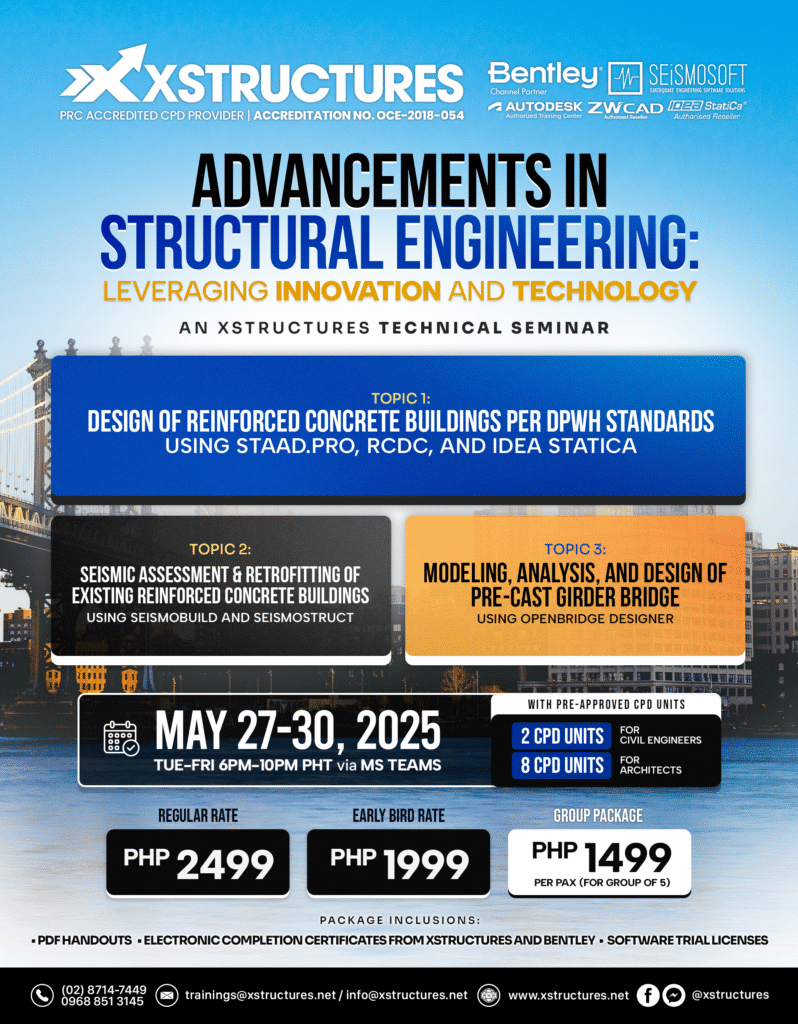ADVANCEMENTS IN STRUCTURAL ENGINEERING: Leveraging Innovation and Technology
An Xstructures Technical Seminar
This course is suited for civil and structural engineers, infrastructure designers, and technical practitioners who are involved in the planning, analysis, and design of buildings and bridges. It is ideal for professionals seeking to deepen their understanding of modern engineering software tools such as STAAD.Pro, RCDC, IDEA StatiCa, SeismoBuild, SeismoStruct, and OpenBridge Designer.
This program comes with PRE-APPROVED CPD UNITS (2.0 FOR REGISTERED CIVIL ENGINEERS; 8.0 FOR REGISTERED ARCHITECTS) upon completion.
SKILL UP. STAND OUT. ENROLL NOW AT XSTRUCTURES!
MAY 27-30, 2025
6PM to 10PM (16 hours)
LIVE ONLINE (MS Teams)
Early bird promo is until May 20, 2025 only.
left to register! Hurry up!
Course Description
This 16-hour technical seminar introduces participants to the latest advancements in structural engineering by showcasing how cutting-edge software tools and innovative methodologies are transforming design and analysis practices. Through a series of case studies and expert-led presentations, participants will explore the design of reinforced concrete buildings per DPWH standards using STAAD.Pro, RCDC, and IDEA StatiCa, the seismic assessment and retrofitting of existing RC buildings with SeismoBuild and SeismoStruct, and the modeling and analysis of precast girder bridges using Bentley OpenBridge Designer. This seminar is designed to broaden the perspective of engineers and professionals on how technology can drive efficiency, accuracy, and resilience in structural design. The seminar is designed to bridge the gap between theoretical knowledge and practical applications, fostering a deeper understanding of cutting-edge engineering solutions.
Course Objectives
This seminar aims to enhance participants’ understanding of the latest advancements in structural engineering by introducing innovative methodologies and technologies. The course will provide insights into best practices, analytical approaches, and compliance with national and international engineering standards. By the end of this course, participants will be able to:
- Understand how to align reinforced concrete building designs with DPWH standards using STAAD.Pro, RCDC, and IDEA StatiCa.
- Analyze structural modeling decisions through real-world DPWH school building case studies, focusing on load assumptions, seismic parameters, and design considerations.
- Gain insights into the detailing and compliance checks of concrete structures using RCDC and the importance of connection design using IDEA StatiCa.
- Learn the fundamentals of performance-based seismic assessment for existing structures and how SeismoBuild and SeismoStruct are used to model and strengthen vulnerable RC buildings.
- Explore various retrofitting strategies and interventions to improve the seismic performance of older concrete buildings.
- Understand the complete workflow for bridge modeling and analysis using Bentley OpenBridge Designer—from terrain and geometry definition to structural design of girders, piers, and abutments.
- Appreciate the impact of software integration and digital workflows in enhancing the efficiency and accuracy of structural engineering practices.
Entry Competencies
This seminar is ideal for civil and structural engineers, infrastructure professionals, architects, educators, and project managers who are familiar with structural engineering principles and are interested in emerging trends and software applications in the field. While hands-on experience with STAAD.Pro, RCDC, IDEA StatiCa, SeismoBuild, SeismoStruct, or OpenBridge Designer is not required, participants should have a working knowledge of structural behavior, building codes, and typical engineering workflows. A background in structural design for buildings or bridges will help attendees maximize the benefits of the seminar. The course is designed for professionals who wish to enhance their technical awareness, decision-making ability, and strategic understanding of how digital innovation is shaping the future of structural engineering.
Prerequisites
No Prerequisites.
COURSE OUTLINE
CASE STUDY: STRUCTURAL ANALYSIS AND DESIGN OF A DPWH SCHOOL BUILDING PROJECT – (0.50 HOURS)
- OVERVIEW OF A DPWH SCHOOL BUILDING PROJECT
- GRAVITY LOAD ASSUMPTIONS AND STRUCTURAL CONSIDERATIONS
- SEISMIC PARAMETERS BASED ON DPWH STANDARDS
STRUCTURAL ANALYSIS AND MODELING WITH STAAD.PRO – (3.50 HOURS)
- PRINCIPLES OF STRUCTURAL MODELING AND LOAD APPLICATIONS
- SECTION ASSIGNMENTS, SPECIFICATIONS, AND BOUNDARY CONDITIONS
- LOADINGS, LOAD COMBINATIONS, AND STRUCTURAL ANALYSIS INSIGHTS
- INTERPRETATION OF ANALYSIS RESULTS FOR DPWH COMPLIANCE
REINFORCED CONCRETE DESIGN USING RCDC – (3.00 HOURS)
- OVERVIEW OF REINFORCED CONCRETE DESIGN PER DPWH STANDARDS
- DESIGN CONSIDERATIONS FOR BEAMS AND COLUMNS IN RCDC
- UNDERSTANDING STRUCTURAL DETAILING AND COMPLIANCE CHECKS
STRUCTURAL CONNECTION DESIGN WITH IDEA STATICA – (1.00 HOUR)
- REVIEW OF ROOF TRUSS DESIGN FROM STAAD.PRO ANALYSIS
- INTRODUCTION TO IDEA STATICA AND ITS ROLE IN CONNECTION DESIGN
- ROOF TRUSS CONNECTION DESIGN AND STRUCTURAL INTEGRITY
OVERVIEW OF SEISMIC ASSESSMENT METHODOLOGY – (1.00 HOUR)
- INTRODUCTION TO PERFORMANCE-BASED SEISMIC ASSESSMENT METHODOLOGY
- IMPORTANCE OF EVALUATING EXISTING REINFORCED CONCRETE STRUCTURES
- OVERVIEW OF SEISMOBUILD AND SEISMOSTRUCT SOFTWARE AND THEIR APPLICATIONS
CASE STUDY: SEISMIC ASSESSMENT OF EXISTING TWO-STOREY REINFORCED CONCRETE BUILDING – (2.00 HOURS)
- METHODOLOGY FOR ASSESSING A TWO-STOREY REINFORCED CONCRETE BUILDING
- KEY CONSIDERATIONS IN MODELING STRUCTURAL COMPONENTS (COLUMNS, WALLS, BEAMS, AND SLABS)
- DEFINING CODE-STANDARD PARAMETERS FOR SEISMIC ANALYSIS
- UNDERSTANDING STRUCTURAL PERFORMANCE AND WEAKNESSES
- IMPORTING SEISMOBUILD MODEL TO SEISMOSTRUCT
SEISMIC STRENGTHENING & RETROFITTING STRATEGIES OF REINFORCED CONCRETE BUILDING STRUCTURES – (1.00 HOUR)
- STRENGTHENING INTERVENTIONS STRATEGY
- CASE STUDY OF DIFFERENT STRENGTHENING APPLICATIONS
INTRODUCTION TO BRIDGE ENGINEERING – (0.50 HOURS)
- OVERVIEW OF BRIDGE COMPONENTS AND THEIR FUNCTIONS
- SELECTION CRITERIA FOR SUPERSTRUCTURE TYPES
- GENERAL BRIDGE DESIGN PROCEDURES AND CONSIDERATIONS
- TYPICAL BRIDGE SECTION AND ITS STRUCTURAL BEHAVIOR
CASE STUDY: MODELING AND ANALYSIS OF PRECAST GIRDER BRIDGE (2 SPAN STRAIGHT BRIDGE) – (3.50 HOURS)
- INTRODUCTION TO BENTLEY OPENBRIDGE DESIGNER
- OVERVIEW OF OPENBRIDGE DESIGNER SOFTWARE
- CAPABILITIES AND APPLICATIONS IN BRIDGE MODELING
- STEP-BY-STEP BRIDGE MODELING PROCESS
- ATTACHING TERRAIN, GEOMETRY, AND ROUTE ALIGNMENT
- IMPORTING TERRAIN DATA AND DEFINING ALIGNMENT
- SETTING UP ROADWAY GEOMETRY AND CONSTRAINTS
- ADDING SUPPORT LINES AND MODELING THE BRIDGE DECK
- DEFINING SUPPORT LOCATIONS
- CREATING AND CONFIGURING THE BRIDGE DECK
- DEFINING THE GIRDERS AND PLACING THE PIER
- SELECTING AND POSITIONING PRECAST GIRDERS
- OVERVIEW OF PIER MODELING TECHNIQUES
- MODIFYING THE PIER AND PLACING ABUTMENTS
- ADJUSTING PIER GEOMETRY AND CONFIGURATIONS
- ADDING ABUTMENTS AND THEIR STRUCTURAL SIGNIFICANCE
- PLACING BEARINGS, STEPPED CAP, AND BARRIERS
- UNDERSTANDING THE ROLE OF BEARINGS IN BRIDGE STABILITY
- FINALIZING STRUCTURAL ELEMENTS
- ATTACHING TERRAIN, GEOMETRY, AND ROUTE ALIGNMENT
- OPENBRIDGE MODELER TO LEAP BRIDGE CONCRETE: ANALYSIS OF PRECAST CONCRETE GIRDER BRIDGE
- SUPERSTRUCTURE
- LOADS
- BEAM DESIGN
- SUPERSTRUCTURE


